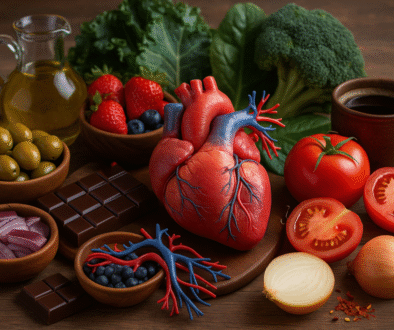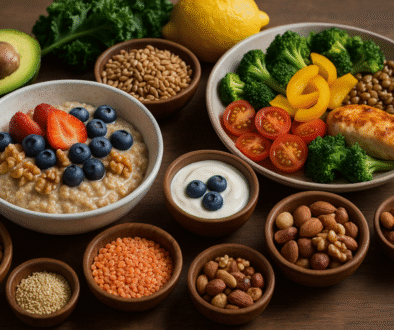Understanding Energy Balance: The Science Behind Calories In vs. Out
Ever wonder why two people can eat the same meal but experience completely different weight changes? The answer lies in energy balance—a deceptively simple concept that holds the key to unlocking sustainable weight management. In a revelatory Huberman Lab podcast, Dr. Layne Norton (PhD in Nutritional Sciences) dismantles myths about calories, metabolism, and diet trends. By the end of this article, you’ll understand exactly how your body processes food energy—and how to leverage this science for real-world results.
What Is Energy Balance?
Energy balance is the relationship between calories consumed (food/drink) and calories expended (metabolism, activity, digestion). Though often reduced to “calories in vs. calories out,” Dr. Norton emphasizes it’s far more complex:
-
Calories measure potential energy stored in food’s chemical bonds
-
Your body converts this energy into ATP (adenosine triphosphate), the cellular “currency” powering everything from breathing to workouts
-
Three macronutrients—carbs, fats, and proteins—take unique metabolic pathways to become ATP
“People say ‘not all calories are equal,’ but a calorie is a unit like a second on a clock. What differs is how foods affect energy expenditure and appetite,” explains Norton.
The Science of Energy Balance & Metabolism
How Calories Become Energy
-
Carbohydrates: Converted to glucose → glycolysis → ATP production
-
Fats: Broken via beta-oxidation into acetyl-CoA → Krebs cycle → ATP
-
Proteins: Used for muscle synthesis OR converted to glucose/ketones → ATP
Why Calorie Labels Lie
-
Food labels can have up to 20% inaccuracies
-
Metabolizable energy varies based on:
-
Fiber content (insoluble fiber reduces usable calories)
-
Gut microbiome efficiency (some extract more energy from fiber)
-
Food structure (e.g., whole almonds vs. almond butter)
-
The 3 Components of “Calories Out”
-
Resting Metabolic Rate (RMR): 50–70% of daily expenditure (higher in sedentary people)
-
Physical Activity: Includes exercise, walking, even fidgeting
-
Thermic Effect of Food (TEF): Energy used to digest meals (5–30% of intake):
Macronutrient TEF Net Calories per 100 Fat 0–3% 97–100 Carbs 5–10% 90–95 Protein 20–30% 70–80
“Protein’s high TEF and satiety make it a powerhouse for weight management,” notes Norton.
3 Actionable Tips to Master Your Energy Balance
1. Prioritize Protein for Metabolic Efficiency
-
Aim for 30% of calories from protein to leverage its 20–30% TEF
-
Examples: Greek yogurt at breakfast, chicken in salads, tofu stir-fries
-
Bonus: Protein supports muscle retention during weight loss (learn more)
2. Track Calories Mindfully
-
Use apps like MyFitnessPal—but account for label inaccuracies (±20%)
-
Focus on consistency over precision: “Like budgeting, estimates work if you’re consistent,” says Norton
-
Track fiber-rich foods separately (e.g., broccoli, oats) to gauge true metabolizable energy
3. Don’t Fear Energy Density—Understand It
-
High-fat foods (nuts, oils) have low TEF but aid satiety
-
Pair fats with protein/fiber (e.g., almonds + apple) to balance energy extraction
-
Cooking affects energy availability: steamed potatoes have fewer net calories than mashed (source)
Common Energy Balance Pitfalls & FAQs
Q: Can eating too much protein make you fat?
A: While protein itself is unlikely stored as fat, excess total calories from any source causes weight gain. Protein’s high TEF and satiety protect against overeating.
Q: Do artificial sweeteners disrupt energy balance?
A: Research is mixed, but Norton notes they can aid weight loss by reducing calorie intake without increasing appetite significantly.
Q: Why do some people gain weight on “healthy” diets?
A: Fiber-rich diets reduce metabolizable energy—but individual gut microbiomes vary. Some extract 10–15% more calories from plants.
Q: Does fasting boost metabolism?
A: Fasting may reduce total daily energy expenditure by lowering activity. TEF is also absent during fasting windows.
Q: How accurate are fitness trackers for “calories out”?
A: They often overestimate burn by 15–30%. RMR testing (via DEXA or indirect calorimetry) is more reliable.
Key Takeaways & Next Steps
Energy balance isn’t just math—it’s biology. Protein’s thermic effect, fiber’s impact on metabolizable energy, and individual gut differences all shape your results. Start here:
-
Audit your protein intake (aim for 1.6–2.2g/kg of body weight daily)
-
Track calories consistently for 2 weeks to identify hidden gaps
-
Experiment with fiber-rich carbs (oats, lentils) to naturally lower net calories
“Mastering energy balance means working with your body—not against it,” says Norton.
Internal Links:



